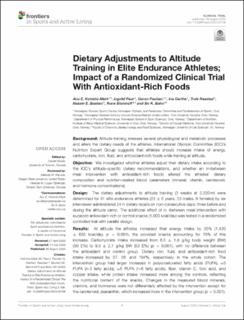| dc.description.abstract | Background: Altitude training stresses several physiological and metabolic processes and alters the dietary needs of the athletes. International Olympic Committee (IOC)'s Nutrition Expert Group suggests that athletes should increase intake of energy, carbohydrate, iron, fluid, and antioxidant-rich foods while training at altitude.
Objective: We investigated whether athletes adjust their dietary intake according to the IOC's altitude-specific dietary recommendations, and whether an in-between meal intervention with antioxidant-rich foods altered the athletes' dietary composition and nutrition-related blood parameters (mineral, vitamin, carotenoid, and hormone concentrations).
Design: The dietary adjustments to altitude training (3 weeks at 2,320 m) were determined for 31 elite endurance athletes (23 ± 5 years, 23 males, 8 females) by six interviewer-administered 24-h dietary recalls on non-consecutive days; three before and during the altitude camp. The additional effect of in -between meal intervention with eucaloric antioxidant-rich or control snacks (1,000 kcal/day) was tested in a randomized controlled trial with parallel design.
Results: At altitude the athletes increased their energy intake by 35% (1,430 ± 630 kcal/day, p < 0.001), the provided snacks accounting for 70% of this increase. Carbohydrate intake increased from 6.5 ± 1.8 g/kg body weight (BW) (50 E%) to 9.3 ± 2.1 g/kg BW (53 E%) (p < 0.001), with no difference between the antioxidant and control group. Dietary iron, fluid, and antioxidant-rich food intake increased by 37, 38, and 104%, respectively, in the whole cohort. The intervention group had larger increases in polyunsaturated fatty acids (PUFA), ω3 PUFA (n-3 fatty acids), ω6 PUFA (n-6 fatty acids), fiber, vitamin C, folic acid, and copper intake, while protein intake increased more among the controls, reflecting the nutritional content of the snacks. Changes in the measured blood minerals, vitamins, and hormones were not differentially affected by the intervention except for the carotenoid; zeaxanthin, which increased more in the intervention group (p < 0.001).
Conclusions: Experienced elite endurance athletes increased their daily energy, carbohydrate, iron, fluid, and antioxidant-rich food intake during a 3-week training camp at moderate altitude meeting most of the altitude-specific dietary recommendations. The intervention with antioxidant-rich snacks improved the composition of the athletes' diets but had minimal impact on the measured nutrition-related blood parameters. | en_US |
